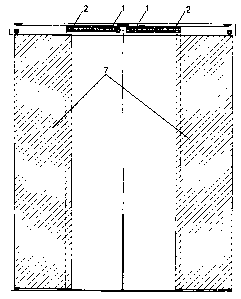Some of the information on this Web page has been provided by external sources. The Government of Canada is not responsible for the accuracy, reliability or currency of the information supplied by external sources. Users wishing to rely upon this information should consult directly with the source of the information. Content provided by external sources is not subject to official languages, privacy and accessibility requirements.
Any discrepancies in the text and image of the Claims and Abstract are due to differing posting times. Text of the Claims and Abstract are posted:
| (12) Patent: | (11) CA 2612464 |
|---|---|
| (54) English Title: | SYNCHRONIZED ACTUATION SYSTEM FOR SLIDING DOORS |
| (54) French Title: | SYSTEME D'ACTIONNEMENT SYNCHRONISE POUR PORTES COULISSANTES |
| Status: | Granted and Issued |
| (51) International Patent Classification (IPC): |
|
|---|---|
| (72) Inventors : |
|
| (73) Owners : |
|
| (71) Applicants : |
|
| (74) Agent: | MARKS & CLERK |
| (74) Associate agent: | |
| (45) Issued: | 2015-02-17 |
| (22) Filed Date: | 2007-11-27 |
| (41) Open to Public Inspection: | 2008-05-28 |
| Examination requested: | 2012-11-27 |
| Availability of licence: | N/A |
| Dedicated to the Public: | N/A |
| (25) Language of filing: | English |
| Patent Cooperation Treaty (PCT): | No |
|---|
| (30) Application Priority Data: | ||||||
|---|---|---|---|---|---|---|
|
The invention relates to a synchronized actuation system for sliding doors, of the type of those formed, in which the improvements consist of the fact that the pulling grip (1) and the free grip (2) have flanges (12) and in that the belt (4) and free (2) and pulling (1) grips are joined by means of a connecting shoe (3). With this configuration it is possible to carry out assembly and maintenance operations vertically and therefore in situ, this being a substantial improvement of the main patent.
Linvention concerne un système dactionnement synchronisé pour portes coulissantes, du type de ceux formés, dans lesquels les améliorations résident dans le fait que la poignée de tirage (1) et la poignée libre (2) possèdent des brides (12) et dans le fait que la courroie (4) et les poignées libre (2) et de tirage (1) sont jointes au moyen dun sabot de liaison (3). Avec cette configuration, il est possible deffecteur des opérations dassemblage et dentretien verticalement et, par conséquent, in situ, ceci représentant une amélioration importante du brevet principal.
Note: Claims are shown in the official language in which they were submitted.
Note: Descriptions are shown in the official language in which they were submitted.

2024-08-01:As part of the Next Generation Patents (NGP) transition, the Canadian Patents Database (CPD) now contains a more detailed Event History, which replicates the Event Log of our new back-office solution.
Please note that "Inactive:" events refers to events no longer in use in our new back-office solution.
For a clearer understanding of the status of the application/patent presented on this page, the site Disclaimer , as well as the definitions for Patent , Event History , Maintenance Fee and Payment History should be consulted.
| Description | Date |
|---|---|
| Letter Sent | 2023-11-27 |
| Common Representative Appointed | 2019-10-30 |
| Common Representative Appointed | 2019-10-30 |
| Inactive: Cover page published | 2015-06-19 |
| Inactive: Acknowledgment of s.8 Act correction | 2015-05-12 |
| Correction Request for a Granted Patent | 2015-03-10 |
| Grant by Issuance | 2015-02-17 |
| Inactive: Cover page published | 2015-02-16 |
| Pre-grant | 2014-12-02 |
| Inactive: Final fee received | 2014-12-02 |
| Notice of Allowance is Issued | 2014-07-21 |
| Letter Sent | 2014-07-21 |
| Notice of Allowance is Issued | 2014-07-21 |
| Inactive: Approved for allowance (AFA) | 2014-07-14 |
| Inactive: QS passed | 2014-07-14 |
| Amendment Received - Voluntary Amendment | 2014-06-17 |
| Inactive: S.30(2) Rules - Examiner requisition | 2013-12-17 |
| Inactive: Report - QC passed | 2013-12-12 |
| Letter Sent | 2012-12-06 |
| Request for Examination Received | 2012-11-27 |
| Request for Examination Requirements Determined Compliant | 2012-11-27 |
| All Requirements for Examination Determined Compliant | 2012-11-27 |
| Application Published (Open to Public Inspection) | 2008-05-28 |
| Inactive: Cover page published | 2008-05-27 |
| Inactive: First IPC assigned | 2008-05-07 |
| Inactive: IPC assigned | 2008-05-07 |
| Inactive: IPC assigned | 2008-04-30 |
| Inactive: Applicant deleted | 2008-01-23 |
| Inactive: Filing certificate - No RFE (English) | 2008-01-14 |
| Filing Requirements Determined Compliant | 2008-01-14 |
| Application Received - Regular National | 2008-01-14 |
There is no abandonment history.
The last payment was received on 2014-11-19
Note : If the full payment has not been received on or before the date indicated, a further fee may be required which may be one of the following
Please refer to the CIPO Patent Fees web page to see all current fee amounts.
Note: Records showing the ownership history in alphabetical order.
| Current Owners on Record |
|---|
| KLEIN IBERICA, S.A. |
| Past Owners on Record |
|---|
| MIGUEL ANGEL TARREGA LLORET |